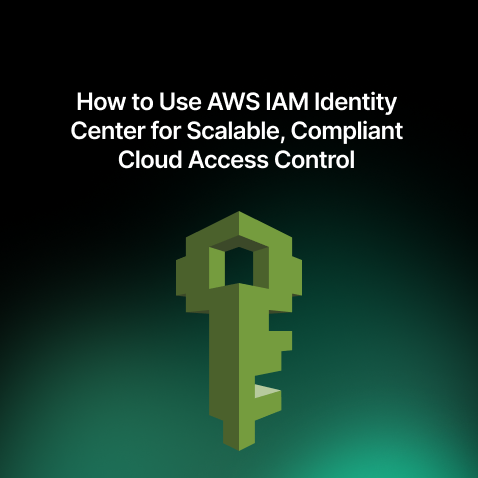Simplify cloud access with AWS IAM Identity Center. Centralize user permissions, enable SSO, and integrate with apps and directories for secure, seamless management.
How to Use AWS IAM Identity Center for Scalable, Compliant Cloud Access Control
- Nitin Yadav
- Blog
About

Industries
- AWS, Cloud Security, Security, SquareOps
Share Via
What Is AWS IAM Identity Center?
Think of IAM Identity Center (previously AWS SSO) as the gatekeeper to your cloud environment. Its role is to make sure only the right users—or services—gain access to your AWS resources, and only with the exact permissions they need. Built as a cloud-based identity management service, it handles authentication and authorization for AWS accounts and other supported business applications, all from a single pane of glass.
The Core Mission
- Centralized access: Decide who enters and what they can do from a single point.
- Seamless authentication: The user logs in once and moves around to authorized applications.
- Integrations galore: Integrates with AWS accounts, enterprise directories, and third-party services.
How Does Identity Center Fit Into AWS?
AWS environments can quickly get complex, spanning multiple accounts, regions, stacks, and workloads. In the past, managing identities, passwords, and permissions across all was a headache. Then came the push for single sign-on (SSO), so users wouldn’t have to juggle a bunch of different logins. That’s where AWS IAM Identity Center steps in.
Here’s how it fits into real-world setups:
- IAM Identity Center unifies access control across all accounts, while AWS Organizations assists in managing multiple accounts.
- Your workforce might use applications outside of AWS, like Microsoft 365, Salesforce, or Atlassian, and IAM Identity Center covers those as well, giving the workforce one login for everything.
- Whether using Microsoft Active Directory or cloud-based providers like Okta or Azure AD, Identity Center integrates smoothly with them.
Key Features
- Centralized User & Group Management
You can create users and groups within Identity Center, import them from external IDPs, or combine the strategies. Mapping groups to specific permissions makes onboarding and offboarding a relief for admins everywhere.
- Fine-Grained Permissions
Permissions are controlled using AWS IAM policies or custom permission sets. You apply them to groups or users, governing least-privilege access across AWS accounts. No more “Oops, I gave everyone admin” moments.
- Single Sign-On (SSO)
SSO is the magic word for user experience. Logging in once, then skipping between AWS services and integrated external apps, saves time and eliminates password fatigue.
- Adaptable Identity Sources
Handle users natively or bind to an outside identity provider using standards such as SAML 2.0. In other words, you can connect your existing workforce directory directly to AWS.
- Audit & Compliance
Each action, login, access request, and privilege grant can be tracked, recorded, and audited. This assists in checking all those compliance boxes and provides a sense of comfort to have a clear picture of who did what, when, and where.
Getting Started
Success with IAM Identity Center is less about wizardry and more about clarity:
Step 1: Enable IAM Identity Center
It’s as simple as navigating to the AWS Management Console, searching for “IAM Identity Center,” and flipping the switch. AWS walks you through the initial setup.
Step 2: Choose Your Identity Source
Inbound users have to come from somewhere! Options include:
- Built-in directory (manage users/groups in AWS)*
- Active Directory (on-premises or AWS Managed AD)*
- External SAML-based provider
Step 3: Connect AWS Accounts & Applications
Select which AWS accounts and external business apps need to be under the access umbrella. AWS has a growing library of pre-integrated apps, including many SaaS stalwarts.
Step 4: Create and Assign Permission Sets
Define permission sets (think: collections of IAM policies). Assign them to groups or users, and map those to the right accounts or apps. The goal here is minimal access with maximum efficiency.
Step 5: Test and Monitor
A test drive never hurts. Log in as a user, verify access, and glance at audit logs. You’ll refine things as you go, almost certainly.
How Organizations Leverage IAM Identity Center
Here is how teams make their lives easier with IAM Identity Center:
- Onboarding & offboarding: Single-step assignment and revocation of privileges when employees join, relocate, or depart. No longer will there be orphaned access.
- Role-based access: Rather than control access one-by-one, utilize groups representing actual-world roles (dev, finance, admin, read-only, etc.).
- External user collaboration: Provide secure, time-limited access to partners or contractors without opening up keys to your kingdom.
- Compliance audit trails: Simplify the auditor’s work with detailed logs of who did what, when.
Lessons Learned and Best Practices
Of course, there’s no journey in the cloud without its humps. IAM Identity Center is robust, but here’s what I make sure to keep an eye out for:
- Overlap of permissions: Double-check permissions, particularly if a user belongs to several groups with conflicting sets.
- Directory sync latency: If using external directories, sometimes sync times bring temporary disarray.
- Custom app support: Not all business apps natively support SAML or OIDC. You might require additional configuration.
- Credential lifecycle: Certain users continue to require long-lived API keys—these need to be handled outside the SSO framework.
When IAM Identity Center Might Not Be Enough
Although IAM Identity Center is well-designed, certain edge cases may require additional configurations or alternative solutions:
- Massive-scale environments: Some organizations with tens of thousands of users and ultra-complex hierarchies might require federated setups or hybrid models.
- Non-AWS resources: For fully multi-cloud or on-prem environments, consider broader tools like Azure AD or Okta.
Final Thoughts
Embracing AWS IAM Identity Center streamlines not only access management but also users’ and admins’ daily lives. Its usability with AWS’ security foundation, tip of the hat to best practices, and flexibility make it a deserving pillar for cloud-based companies. My suggestion? Start small, experiment, and test things out. You’ll likely see both team morale and your security posture improve as manual, time-consuming processes fade into the past.
Frequently asked questions
What is AWS IAM Identity Center and how does it work?
AWS IAM Identity Center is a cloud-based service that manages user access across AWS accounts and third-party apps. It provides centralized authentication, authorization, and single sign-on (SSO) to simplify secure access control for organizations of any size.
What is the difference between AWS IAM and IAM Identity Center?
IAM manages permissions within a single AWS account. IAM Identity Center centralizes access across multiple AWS accounts and external apps, offering user-friendly single sign-on and integration with identity providers like Active Directory or Okta.
Can AWS IAM Identity Center integrate with Active Directory?
Yes, IAM Identity Center integrates with on-premises Active Directory, AWS Managed Microsoft AD, and other external identity providers via SAML 2.0. This allows centralized access control using your existing enterprise directory.
How do permission sets work in AWS IAM Identity Center?
Permission sets are predefined IAM policies assigned to users or groups. They control access levels across AWS accounts and resources, ensuring consistent, least-privilege access without creating separate IAM roles in each account.
How does single sign-on (SSO) improve AWS security and user experience?
SSO improves security by reducing password fatigue and login risks. Users log in once to securely access all authorized AWS services and apps, enhancing both convenience and compliance.
Can IAM Identity Center be used for non-AWS applications?
Yes, IAM Identity Center supports SAML-based integration with third-party applications like Salesforce, Microsoft 365, and Atlassian, enabling centralized access management beyond AWS infrastructure.
What are the benefits of using AWS IAM Identity Center for compliance?
IAM Identity Center provides audit logs, access tracking, and permission control. These help organizations meet compliance requirements like SOC 2 and HIPAA while improving transparency and security oversight.
How do I get started with AWS IAM Identity Center?
Enable the service in the AWS Console, choose your identity source, link AWS accounts and apps, define permission sets, assign access, and test login functionality. Setup is guided and straightforward.
What are common challenges with the IAM Identity Center?
Issues include permission conflicts, directory sync delays, lack of native support for some apps, and the need to manage API credentials separately from SSO workflows.
When should you not use AWS IAM Identity Center?
IAM Identity Center may fall short in massive enterprises or multi-cloud environments. Organizations needing complex federations or broad non-AWS integrations may benefit more from platforms like Okta or Azure AD.
Related Posts

Comprehensive Guide to HTTP Errors in DevOps: Causes, Scenarios, and Troubleshooting Steps
- Blog
Comprehensive guide for DevOps on HTTP errors: causes, scenarios, and troubleshooting tips, covering status codes, SSL issues, CORS, timeouts, and server misconfigurations.

Trivy: The Ultimate Open-Source Tool for Container Vulnerability Scanning and SBOM Generation
- Blog
Explore Trivy: a fast, open-source tool for container vulnerability scanning and SBOM generation. Learn how it secures DevOps pipelines with ease and transparency.

Prometheus and Grafana Explained: Monitoring and Visualizing Kubernetes Metrics Like a Pro
- Blog
Set up Prometheus and Grafana for real-time monitoring and visualization in Kubernetes environments. Learn step-by-step configuration and best practices for DevOps success.

CI/CD Pipeline Failures Explained: Key Debugging Techniques to Resolve Build and Deployment Issues
- Blog
Learn how to identify and fix CI/CD pipeline failures—from environment mismatches to flaky tests—with practical solutions for reliable, efficient DevOps workflows.

DevSecOps in Action: A Complete Guide to Secure CI/CD Workflows
- Blog
DevSecOps integrates security into CI/CD pipelines, enabling early threat detection, compliance, and resilient infrastructure through automated security practices.

AWS WAF Explained: Protect Your APIs with Smart Rate Limiting
- Blog
AWS WAF protects web apps by filtering malicious traffic, blocking threats like SQL injection & XSS, and enabling custom rules, rate limits, and real-time monitoring.

